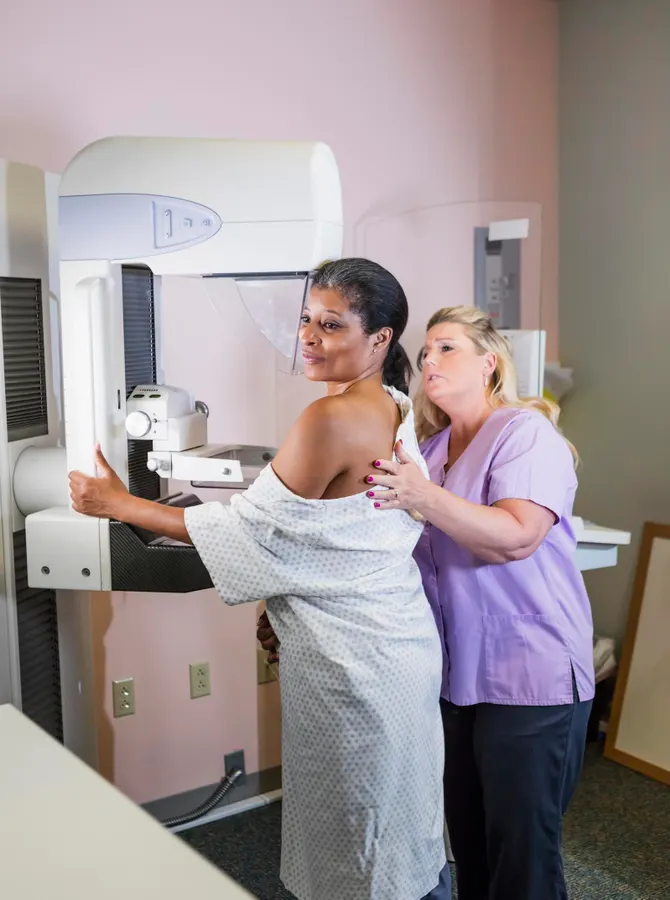Copyright forbes

A mature African-American woman in her 40s wearing a hospital gown, getting her annual mammogram. She is being helped by a technologist, a blond woman wearing scrubs. There has been emerging research that has found that common everyday cosmetic and household products that are heavily marketed to Black women make them more at risk to develop more aggressive forms of breast cancer and are thought to contribute to them being more likely to die from cancer compared to other racial and ethnic groups. Throughout the month of October, millions of women have gathered to participate in various events to spread awareness in honor of Breast Cancer Awareness month. While there has been an 44% decline in overall breast cancer deaths since 1989 —in part due to increased awareness, earlier diagnoses, and more effective treatments -- breast cancer continues to be the most common cancer and the leading cause of death in women in the U.S. It is projected that in 2025, over 315,000 new cases of invasive breast cancer and 59,080 new cases of ductal carcinoma in situ (also known as stage 0 breast cancer) will be diagnosed in women in America, and these numbers are even more staggering for Black women. Experts in the field are pointing to various social, economic, genetic, and environmental factors to help better understand this disparity. The mortality gap between Black women and white women has been profound and persistent. Despite Black women having a 4% lower incidence rate of breast cancer than white women, they have a significantly higher breast cancer death rate. In fact, the American Cancer Society recently reported that Black women have a 40% higher death rate from breast cancer compared to white women and this disparity is even larger among women under 50 years of age. Overall, young women have a higher incidence of aggressive cancers, and young Black women have double the mortality rate of young white women. Similar research has also found that triple negative breast cancer (hormone receptor negative/HER2 negative), a subtype of the disease that is both more aggressive and associated with a higher mortality rate, and inflammatory breast cancer are both more common among Black women than other racial or ethnic groups. Recent results from two large clinical trials have revealed that despite having similar recurrence scores, Black women with hormone receptor–positive/HER2-negative, lymph node–positive breast cancer had worse outcomes compared to Asian, Latinx, and white women. Other studies have examined this disparity and indicate that breast tumors in Black women respond differently to endocrine therapy and may more frequently become resistant to therapy. That said, the gap in breast cancer incidence and outcome among Black women is complex, multifactorial, and extends beyond genetics. Social, economic, geographic, and lifestyle factors may partially account for disparities. Black women are statistically more likely to have diabetes, heart disease, and obesity due to systemic racism and inequalities that perpetuate poverty, unemployment, and living in food deserts. Black women are also less likely to breastfeed after childbirth due to lack of education and resources on how to breastfeed. Additionally, research suggests that Black women are also more likely than white women to have inadequate health insurance or access to health care facilities, which may affect screening, follow-up care, and completion of therapy. Coincidently, these are all considered to be risk factors for breast cancer. For example, a 2017 study looking at women between the ages of 18 and 64 who were diagnosed with early-stage breast cancer found that these four key factors accounted for over 76% of the total mortality risk in Black patients, and 37% of Black women’s excess mortality risk could be explained by a lack of private health insurance. Likewise, a 2019 study that analyzed characteristics of breast cancer patients on a city level showed that women with increased access and resources -- such as educationtional attainment and income -- may be better equipped to take advantage of healthcare advances. So, it is no surprise that cities that have confronted this problem by increasing access to state-of-the art mammography facilities made significant progress in narrowing the breast cancer mortality gap between Black and white women. MORE FOR YOU More recently, there has been a growing body of research that has found other environmental factors that help explain this disparity. A 2024 study that analyzed 5,000 women found that the following risk factors made Black women more likely to die from cancer or to develop more aggressive forms of breast cancer: Black women who used hair dye at least every 5–8 weeks had a 60% higher breast cancer risk. Black women who didn’t get mammograms on a regular basis were three times more likely to be diagnosed with later-stage (3 or 4) breast cancer versus stage 1. Black women living below the federal poverty line were almost twice as likely to be diagnosed with later-stage (3 or 4) breast cancer versus stage 1. Similar studies have linked heavy usage of certain products to this disparity as well. These products are often marketed to Black women more than other racial and ethnic groups and contain highly harmful and toxic ingredients: Skin lighteners Hair relaxers Brazilian blowout treatments Some synthetic hair extensions While it is important for Black women to educate themselves on the ingredients of the products they use, it is equally as critical for all women to be aware of certain products that increase the overall likelihood of developing cancer that are not just primarily marketed to Black women – but to all women regardless of racial or ethnic background. Some of these include: Acrylic nails Lead: Some synthetic hair and costume jewelry products have been found to contain lead. Phthalates: These chemicals are found in many personal care products such as certain lotions, shampoos, hairsprays, and nail polishes and have been linked to health concerns, including cancer. Fragrances and perfumes: A number of products containing fragrances, such as perfumes, air fresheners, and scented candles, have been found to contain chemicals of concern. Again, it’s important to keep in mind that although there are certain products that have been found to be marketed to Black women more than white women – putting them more at risk to being exposed to harmful cancer-causing carcinogens – the above listed products can potentially place anyone at risk. Experts also caution that the duration of use of these products also plays a big role in exposure and negative outcomes. Some studies have noted that the risk of developing breast cancer can increase with the duration of use for certain products, such as hair relaxers. Additionally, many everyday products contain EDCs such as cosmetics, and cleaning supplies which can interfere with the body's hormone systems and have been linked to diseases like breast cancer. Editorial StandardsReprints & Permissions



